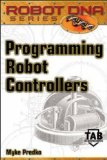In a world dominated by personal computers, there is room left for applications running on microcontrollers. Beginning with home appliances and ending with robotic manipulators used in space missions, microcontrollers are still the optimal choice of many system designers. It seems that in computer-land you do not have to be big, strong, and/or fast in order to be smart… there are even examples of Kalman filter implementations running on microcontrollers.
Today I recommend you a book on programming microcontrollers – Programming Robot Controllers. The book focuses on using microcontrollers for robot control and has the declared goal to provide robot designers with the knowledge and the tools that will help guarantee that his/her robot will perform to expectation and specification and can be easily modified.
Myke Predko, the author, uses the Microchip PICmicro PIC16F627 chip for the example circuits presented in the book. Despite the modest performances of the microcontroller (PIC16F627 is a 18-pin device, providing 1K instruction space and 68 bytes of variable memory, two 8-bit timers, a 16-bit timer, serial communications, and a single-vector interrupt capability), it is very popular for robot applications. Assembly language enthusiasts might be a little bit disappointed because the code examples in the book are written in C. But there is an advantage to that… if you want to port the robot code, the compiler will do most of the work for you.
The author introduces three different spectrums in describing how software is written for robots. Depending on the requirements for the code response/execution speed, the code can be biologic, mechalogic, and elelogic. Don’t bother to look up the last two in the dictionary… they are new terms. In a nutshell, the biologic code makes the high-level decisions providing the high-level intelligence demonstrated by the robot, the mechalogic code controls the mechanical devices built into the robot, and the elelogic code provides intercomputer communications and some interface and output functions.
After an introduction focused on the specifics of software development for microcontrollers and a detailed description of the microcontroller itself, the book presents devices that are external to the microcontroller and how they can be integrated into a general robot architecture: RS-232 interfaces, LEDs, LCDs, IR sensors, sound sensors, motor controllers, odometers, and radio control servos. The author points out that it is easy to build a robot, but it is much more difficult to get it to work properly or as expected. The conclusion is that designing the robot system is an important step of the process.
If you plan to build your own exploration rover, design a micro-satellite bus, or put together a robot manipulator, Programming Robot Controllers is a good book to start with.










 Subscribe to our RSS feed
Subscribe to our RSS feed











There are no comments.
Add A Comment